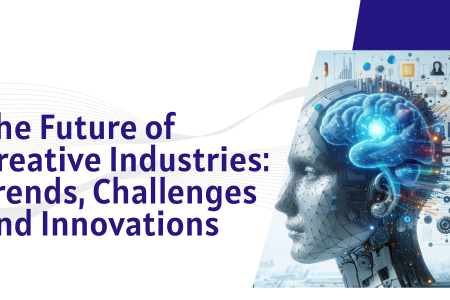The creative industries have become a driving force of global innovation and economic growth. As technology continues to evolve, new trends are reshaping the landscape of creativity, from digital art to artificial intelligence-driven design. Researchers and academics interested in this field must stay updated with emerging technologies, market shifts, and consumer behavior trends. This article explores the current trends and future outlook of creative industries, offering insights into what researchers should be focusing on.
What Are the Creative Industries?
The creative industries encompass a wide range of sectors where creativity, knowledge, and talent drive economic growth, shaping the future of creative industries and influencing global markets. These industries include:
- Advertising and marketing
- Architecture
- Crafts and design
- Film, television, and video production
- IT, software, and video games
- Music, performing arts, and visual arts
- Publishing
- Museums, galleries, and libraries
Top Trends in the Creative Industries
1. The Rise of AI in Creativity
Artificial Intelligence (AI) is no longer just a tool; rather, it has become an active collaborator in the creative process. Consequently, AI-powered tools like ChatGPT, DALL·E, and MidJourney are revolutionizing content creation, design, and storytelling. Moreover, AI can now generate unique images, music, and even full-length scripts, reducing production time and costs while offering fresh inspiration to human creators. As AI technology continues to advance, its integration into creative workflows is becoming more seamless and impactful. Ultimately, AI is transforming how creators conceptualize and execute their ideas.

2. The Expansion of the Metaverse
The metaverse is a virtual, immersive space that allows users to engage with digital content in new ways. As a result, from virtual concerts and art galleries to digital fashion and NFTs, the metaverse is providing unprecedented opportunities for artists and designers to monetize their work and connect with audiences globally. Furthermore, businesses and brands are increasingly leveraging the metaverse for marketing, entertainment, and customer engagement, making it an essential space for future creative developments. In the long run, the metaverse will continue to redefine digital interactions.
3. Sustainability and Eco-Conscious Creativity
Sustainability has become a core focus in creative industries. As a result, brands and artists are increasingly adopting eco-friendly materials, ethical production processes, and circular design principles. Additionally, sustainable fashion, digital art to reduce carbon footprints, and eco-conscious branding strategies are gaining traction in global markets. Consequently, the shift toward sustainability is influencing how companies approach product development, marketing, and audience engagement.
4. Personalization and Data-Driven Creativity
Consumers now demand more personalized experiences. By leveraging big data, machine learning, and user analytics, brands can craft highly targeted content and marketing campaigns. This shift is particularly evident in digital marketing, music streaming, and video content, where AI-driven recommendations are optimizing engagement.
5. The Gig Economy and Remote Collaboration
The rise of freelancing platforms like Upwork, Fiverr, and Behance has made it easier than ever for creative professionals to work remotely and collaborate globally. Virtual teams are now the norm, and cloud-based tools like Adobe Creative Cloud, Notion, and Miro facilitate seamless remote collaboration across different time zones.
6. The Growth of Digital and Virtual Art Markets
NFTs (Non-Fungible Tokens) have revolutionized the digital art world. Consequently, artists can now sell unique digital assets with verifiable ownership. While the NFT market has seen fluctuations, blockchain technology continues to evolve, offering promising solutions for intellectual property protection and monetization. Additionally, virtual galleries and decentralized marketplaces are expanding opportunities for digital creators.
7. Immersive Storytelling with AR and VR
Augmented Reality (AR) and Virtual Reality (VR) are redefining storytelling by making content more interactive and engaging. As a result, industries like gaming, film, advertising, and education are increasingly incorporating AR/VR to create immersive brand experiences, training simulations, and interactive narratives. Furthermore, with advancements in hardware and software, the accessibility of AR/VR content is growing, making it a significant area for creative exploration.
8. Social Media as a Creative Hub
Social media platforms like TikTok, Instagram, and YouTube have become powerful creative outlets. Consequently, content creators are shaping trends and influencing industries through short-form videos, viral marketing campaigns, and influencer-driven storytelling. Moreover, businesses are adapting their branding strategies to keep up with these rapidly evolving platforms. As social media algorithms prioritize engagement and originality, creative professionals must constantly innovate to stay relevant.
9. The Democratization of Creativity
Technology has significantly lowered the barrier to entry for creative professionals. Moreover, no-code and low-code platforms, AI-powered design tools, and open-source software have made it easier for individuals to launch creative projects without formal training. As a result, platforms like Canva, Wix, and Unity enable users to create high-quality visuals, websites, and games with minimal effort.
10. The Role of Academia in Shaping Creative Industries
Academic research plays a crucial role in understanding and advancing the creative industries. Therefore, topics like digital ethics, copyright laws, AI-generated content, and creative entrepreneurship are gaining traction in research institutions. Furthermore, universities and think tanks are actively studying the socioeconomic impact of these industries and, as a result, proposing policies to support creative professionals.
Challenges Facing the Creative Industries
Despite their rapid growth, the future of creative industries faces several challenges, including:
- Intellectual property concerns in the digital age
- Market saturation and competition
- Sustainability issues in mass production
- Adapting to emerging technologies and shifting consumer behavior
- Ensuring fair compensation and recognition for artists and designers
Conclusion
The future of creative industries is at a pivotal moment, driven by technology, sustainability, and innovation. As AI, AR/VR, and blockchain reshape creativity, researchers must explore their impact on economies, cultures, and creators. Therefore, embracing emerging technologies, ethical considerations, and sustainable practices will ensure a resilient and inclusive industry. Ultimately, the fusion of technology and human creativity remains key to unlocking new possibilities in art, design, and storytelling.
The Sustainability in Creative Industries 4th Edition Conference in collaboration with Universitas Ciputra serves as an essential platform for academics, industry leaders, and policymakers to discuss the pressing challenges and opportunities in sustainable creativity. Moreover, this event fosters collaborative discussions, innovative research presentations, and actionable strategies to ensure that creativity continues to thrive in an environmentally responsible manner. Therefore, attending and actively engaging in such discussions will be crucial for shaping the next phase of sustainable creative industries.
